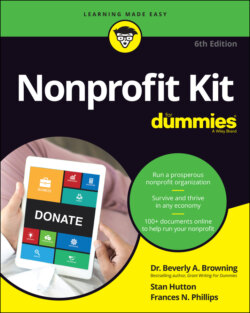Читать книгу Nonprofit Kit For Dummies - Stan Hutton, Beverly A. Browning - Страница 51
HYBRID CORPORATIONS: NEITHER FISH NOR FOWL?
ОглавлениеSome states have passed legislation that allows for the formation of corporations that can earn and distribute profits to shareholders but also must pay attention to the social and public benefits of their business. Efforts to create these new corporate entities, which blend the best of the nonprofit and for-profit worlds, arise largely from the corporate social responsibility movement, which has grown substantially during the past 30 years.
You may have heard the term double bottom line, a concept that essentially means businesses should not only try to make profits but also work toward improving the social condition of their workers and customers and the environment in which they operate. To that end, many companies have corporate giving programs that support nonprofit organizations in their communities, as well as programs that encourage employees to volunteer for local charitable groups. In the case of the new hybrids, however, corporate responsibility isn’t optional; companies are obliged to consider the social impact of their activities and work toward making the world a better place.
The following three corporate models fall into the hybrid category. As such, they all have one thing in common: In the eyes of the IRS, they’re viewed as for-profit entities, and their income is taxable as in any for-profit business. That means if you wanted to make a donation to the work of a hybrid corporation, the IRS wouldn’t allow you to claim your contribution as a charitable gift.
Low profit limited liability companies (L3Cs): The L3C model was designed to better attract capital investments from investors seeking a return on their money, as well as program-related investments (PRIs) from foundations. (PRIs are typically loans from foundations, not grants.) Foundations can count the funds used to provide PRIs toward their charitable-spending requirements as long as the charitable purpose of the project furthers the foundations’ charitable purposes. The governing documents of the L3C are designed to make this approval easier to receive. So far, the IRS hasn’t approved blanket acceptance of all PRIs awarded to L3C companies. Find more information about the L3C hybrid corporation on the Americans for Community Development website (
www.americansforcommunitydevelopment.org).B-Corp organizations: B-Corps must adhere to certain accountability and transparency standards and have positive impacts on society and the environment. The nonprofit organization known as B-Labs (
www.bcorporation.net) is leading the B-Corp accountability standards and advocacy efforts toward encouraging state lawmakers to pass legislation establishing this corporate model. B-Labs compares the B-Corp movement to fair trade certification, which ensures that products are produced in an equitable, environmentally sound manner.Flexible purpose corporations (FPCs): Sometimes called social purpose corporations, this newest form of hybrid corporation is similar to the B-Corp, except that it must have a more specific charitable purpose. Accountability and transparency standards for FPCs are developed internally by the corporations rather than by outside certifying agencies.
Although the notion of doing good in the world while still being allowed to make a profit is attractive, we recommend approaching these new corporate forms with caution. It’s still early in this movement, and it’s difficult to predict how effective these new hybrid corporations will be. If you’re thinking of establishing an L3C or another hybrid organization, consult an attorney who’s knowledgeable in this field before moving forward.
